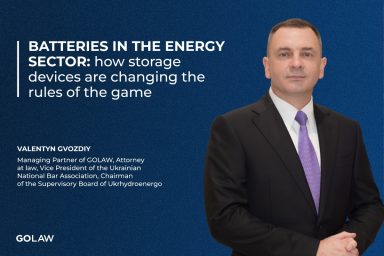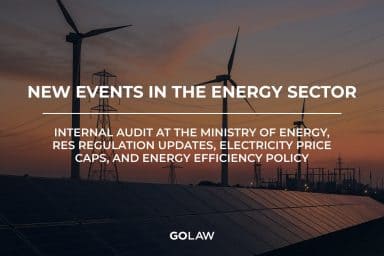Challenges on the Swedish electricity market
Taking into account the crisis processes in the global energy sphere and the audience’s interest in studying this issue, GOLAW invited the leading energy expert Markus Mårline – a lawyer, partner of the Swedish law firm Advokatbyrån Sigeman & Co, to talk about the Swedish electricity market, its prospects and challenges.
The Swedish electricity market is in a special situation that differs from most other European states. Sweden produces more electricity than what is used domestically and is thus a net exporter of electricity. Furthermore, Sweden is not dependent on natural gas and already has a very high proportion of fossil-free and renewable energy. Despite these good conditions, electricity prices are increasing fast, and the Swedish electricity market is facing major future challenges.
To fully understand current and future problems in the Swedish electricity market, it is important to understand what Sweden looks like geographically, where in Sweden most people live and where in Sweden electricity production takes place.
Sweden is long and narrow, encompassing an area of 528 447 km², i.e. almost 90 percent of the area of Ukraine, but with a population of only 10 million, i.e. about 25 percent of the Ukrainian population. Sweden spans approximately 1 600 km from north to south and 500 km from west to east. The population is largely concentrated in the southern half of Sweden, with only 10 percent of the Swedish people living in the northern half of Sweden. At the same time, the northern part of Sweden accounts for about 60 percent of the total electricity produced in Sweden.
The electricity generation in Sweden is 98 percent fossil free. Most of Sweden’s electricity supply comes from hydropower and nuclear power, along with a growing contribution from the wind. In 2021, Sweden produced a total of 165 TWh and the consumption amounted to 140 TWh, which makes Sweden a net exporter of electricity, with interconnectors to Finland, Lithuania, Poland, Germany, Denmark, and Norway.
Since heating is supplied mainly through bioenergy-based district heating and heat pumps, Sweden is not dependent on natural gas. Thus, the share of green energy supply in Sweden is, also considering the total energy consumption (and not only electricity), very high compared to most other states in Europe.
Since most people live in the south and most electricity is being produced in the north, Sweden is dependent on a robust electricity grid that can transport the electricity produced in the north to the south.
However, during the last 20-30 years it has been evident that the Swedish electricity grid cannot meet the demand to supply southern Sweden with electricity and export electricity to the neighboring countries.
Until 2011, the capacity problems were handled by limiting exports so that the domestic electricity demand was met before any export took place.
After complaints from a Danish energy association, the European Commission initiated a case against Sweden regarding an alleged violation of the EU Treaty due to illegal export restrictions and abuse of EU anti-trust legislation. After negotiations with the commission, Sweden accepted to set up four different bidding zones from north to south.
The electricity exchange then calculates an hourly electricity price for each bidding zone. The purpose of this model is to indicate constraints in the transmission systems and to ensure that regional market conditions are reflected in the price in each zone.
Due to congestion in the transmission system, bidding zones may get different prices. When there are constraints in transmission capacity between two bidding zones, electricity will always go from the low-price area to the high-price area.
The difference between the selling price (in the low-price area) and the purchase price (in the high-price area) of the electricity that is transmitted between two areas is collected by the electricity exchange and distributed to the Swedish TSO and shall be used to strengthen the grid, building new interconnectors, etc. The price differences have historically been quite modest but during the last couple of months, the difference in electricity prices between the northernmost bidding area and the southern bidding area has been increasing, with prices in the south that occasionally have been up to 100 times higher than in the north.
With a surplus of electricity on a national level but with high electricity prices in the southern part of Sweden, strengthening the Swedish transmission grid with new cables that increases the capacity for electricity transmission from north to south is crucial for maintaining a well-functioning electricity market.
The fact that more transmission capacity in the grid is needed has been known for a long time and a lot of grid projects have also been carried out to mitigate the problems with congestion.
Although major grid projects are expensive, the major problem in these projects is not financing, but time-consuming permit processes and all the various conflicting interests that, according to Swedish legislation and EU law, must be considered in these types of projects.
Such conflicting interests include, inter alia, environmental interests, protection of particularly sensitive areas (areas according to the EU Habitats Directive, nature reserves, water protection areas, etc.), protection of certain specific species (e.g. according to the EU’s Birds Directive), military interests, etc.
Other conflicting interests that must also be considered in these types of infrastructure projects are individual interests and especially private ownership that is protected both under Swedish national law and under international conventions, such as the European Convention on Human Rights.
The handling of all conflicting public and individual interests and the investigations that are required relating to alternative methods, alternative locations, necessary precautions, etc., often implies that granting of permits takes a long time. Not infrequently, permissions are also followed by court proceedings, which often delay the projects even more. A major cable project on the Swedish national transmission grid can take up to ten years from the internal decision until the cable is commissioned, and sometimes longer than that.
In addition to expanding and strengthening the Swedish grid, Sweden is also in need of new production facilities, especially in the southern parts. Recent studies have shown that the electricity use in Sweden will increase from 140 TWh per year in 2021 to 250-310 TWh per year in 2045, mainly due to the electrification of industries and the electrification of the transport sector.
Ever since the early 1980s, the political line in Sweden has been to gradually phase out nuclear power. Even if the public and political opinion perhaps have changed in recent years, and the opinion against nuclear power no longer is as strong as it was in the early 1980s, the reality is that no new nuclear power plants are being planned, and those that are in use are shut down when they have reached their technical and economical lifespan.
The focus now is instead to try to rapidly increase the construction of new production facilities, mainly wind power.
Onshore wind power is continuously being built in Sweden, however not to the extent that Sweden will be able to rely on onshore wind power to meet a future increase in electricity use or to be the one alternative to nuclear power.
Since Sweden has a long coast, there are at least theoretically good conditions for offshore wind power. However, it has proved difficult in Sweden to obtain permission for offshore wind power. Sweden has a very decentralized model for offshore wind power permits and grid connections, where the Swedish state in the past has not taken any initiatives in choosing locations and proposing projects.
Instead, it is for the developers to find suitable locations and apply for all necessary permits and grid connections. The Swedish model differs a lot from models that are used in many other EU states. The Swedish model has proven to be unpredictable for the developers and leads in the vast majority of cases to the project’s failure to receive the necessary permits.
One major problem has been that the Swedish military has opposed about 90 percent of all applications due to the proposed locations of the projects, on the grounds of “national security”.
Of the remaining 10 percent, many projects have been denied permission due to environmental or other similar reasons. This has had the unfortunate consequence that no new offshore wind power turbines have been commissioned in Sweden since 2013. Now, however, interest is at a record high level and there are many applications submitted for environmental permits and grid connections.
The difficulties in realizing projects have led to the Swedish government giving some Swedish authorities various assignments to stimulate and accelerate the development of offshore wind in Sweden.
For example, the Swedish government has given Swedish governmental authorities, including inter alia the Swedish TSO, the Swedish military, the Swedish Energy Agency and the Swedish Environmental Protection Agency, an assignment to jointly investigate and point out certain water areas that are suitable for offshore wind power.
Another example is that the Swedish TSO has been given the assignment to expand the state-owned transmission grid to areas within Sweden’s maritime territory where there are conditions for building several electricity production facilities and where such expansion promotes the fulfillment of Sweden’s goals for renewable electricity production. These two initiatives are expected to lead to an increase in completed offshore wind power projects in the coming years.
Summary
Sweden is a net exporter of electricity, and more or less all electricity that is produced in Sweden is generated from fossil-free resources. Also, if you look at the total energy use in Sweden, a very large part is generated from fossil-free resources, and Sweden is not dependent on natural gas. Despite the good starting point in comparison with the current situation in most European states, Sweden is facing major challenges in the next 10-20 years with an urgent need for additional electricity production and increased transmission capacity, to be able to meet a future increased electricity demand.
The author of the guest blog – Markus Mårline, lawyer and partner at the Swedish law firm Advokatbyrån Sigeman & Co.
Sign up to be aware
New achievements are inspired by information. GO further, don’t miss out GOLAW news and legal alerts
Our expertise
-
- Antitrust and Competition
- Banking and Finance
- Compliance, Corporate Governance and Risk Management
- Corporate and M&A
- Criminal and White Collar Defence
- Defense in Anti-corruption procedures and regulations
- Labor and Employment
- Natural Resources and Environment
- Government Relations (GR)
- Insolvency and Corporate Recovery
- Intellectual property
- International trade
- Legal support of business and private Сlients in Germany
- Litigation and dispute resolution
- Private clients
- Real Estate and Construction
- Energy and Natural Resources
- Restructuring, Claims and Recoveries
- Martial Law
- Tax and Customs
-
- Agribusiness
- Aviation
- Chemical industry
- Engineering, Construction and Building Materials
- Natural Resources and Environment
- Financial institutions
- IT and AI
- Industry and manufacturing
- Healthcare industries, Life sciences and Pharmaceuticals
- Media, Entertainment, Sports and Gambling
- Retail, FMCG and E-Commerce
- Transport and Logistics
We use cookies to improve performance of our website and your user experience.
Cookies policy
Cookies settings







